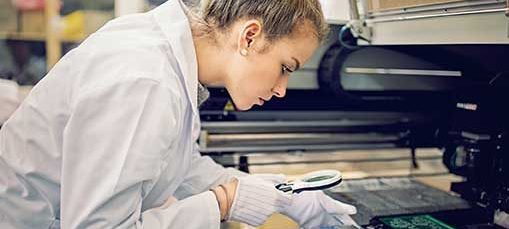The CHIPS and Science Act positions the U.S. to capitalize on skyrocketing chip demand. But who will make the chips?
The U.S. is making a massive investment in its semiconductor industry. The CHIPS and Science Act positions the U.S. to capitalize on skyrocketing chip demand. But who will make the chips?
Experts project the act will create 115,000 new jobs in the semiconductor space, an increase of 33% from current levels. Nearly 60% of those positions risk going unfilled if graduation rates remain stagnant. We’re already seeing the worker shortage’s impact. The Taiwan Semiconductor Manufacturing Company had to delay its Arizona plant’s production start date due to an insufficient number of skilled workers.
To compete globally, the U.S. must build a larger, more diverse semiconductor workforce, which can only be accomplished by expanding awareness, education, and collaboration.
The benefits of a diverse workforce
A more diverse workforce increases the number of potential workers who can fill critical industry roles and strengthens innovation.
Individuals with different backgrounds and experiences bring unique perspectives, creativity, and empathy, enriching product design, business strategy, and problem-solving. Increasing representation of women and minorities in STEM fields helps identify and mitigate bias in data, processes, and outcomes.
The benefits of a diverse semiconductor workforce are myriad. However, women comprise half of the global population and only account for a quarter of industry workers. About 4% are Black and 13% Hispanic, levels lower than the American workforce as a whole. How can we build the talent pool necessary for global success? These three strategies can move the needle.
1. Make STEM interesting
Science, engineering, and math are fascinating subjects. But the general population tends to find them dull. Even I remember learning about electromagnetism in engineering class and thinking, why do I care? The semiconductor industry — and STEM fields in general — must make the subject matter engaging and relevant.
Many people hear “semiconductor” and picture a tiny chip or a supercomputer. They don’t comprehend the extent to which we all use semiconductors. Chips power our smartphones, cars, household appliances, watches, and credit cards. Highlighting how the technology applies to the real world can generate interest and demonstrate the societal impact of a career in the field.
2. Expand educational opportunities
Diversifying and expanding the workforce requires providing more formal and informal educational opportunities.
STEM must be an integral part of education beginning at an early age. To build on that knowledge, children should also have access to fun extracurricular programs to encourage learning. Organizations like Girls Who Code and Black Kids Code expose underrepresented groups to STEM and its opportunities, supporting their pursuits and building confidence.
Increasing access to more advanced training may include funding scholarships specifically for engineering students or giving additional grants to colleges serving underrepresented students. High-tech manufacturers could design their own training programs to build a pipeline of qualified individuals. Establishing first-class engineering institutions outside traditional tech hubs and urban centers creates opportunities for a larger population.
3. Build partnerships
Developing a strong workforce requires collaboration. High-tech manufacturers can partner with schools and universities to promote STEM education, recruit students, and build robust training programs. This cooperation ensures students graduate with the necessary skills to work in the semiconductor industry.
Manufacturers should engage with and invest in their communities by funding community-driven programs providing STEM education opportunities to underserved populations.
Companies joining forces with others in the industry can share resources, develop training programs, and advocate for policies supporting STEM education and workforce development.
The CHIPS Act and workforce development
The CHIPS Act supports efforts to expand the talent pool by providing crucial funding for workforce development, with a focus on increasing diversity.
The law allocates resources for STEM education from kindergarten to graduate school and supports initiatives to diversify the research institutions eligible for funding, particularly Historically Black Colleges and Universities (HBCUs) and other minority-serving schools and research facilities. Additionally, the act funds programs to develop new innovation centers across the country and create jobs in persistently distressed communities. The newly established National Semiconductor Technology Center serves as a hub for collaboration between industry, academia, and government on semiconductor research and development.
Under the CHIPS Act, organizations accepting government incentives must demonstrate significant community and worker investments to ensure support for equitable economic growth and development. The government also provides agencies and institutions with tools to combat sexual and gender-based harassment in science fields.
We will not meet the semiconductor industry’s growing workforce needs with the existing candidate pool. To drive product innovation and solidify this industry, we must make every effort to reach and develop new talent to fill critical roles and diversify perspectives.
About the Author
 Gloria Kee is the Vice President of Product Management at Model N. For more than 16 years, Kee has spent her time focused on product management and with an in-depth understanding of implementing and designing innovative software across a variety of business challenges. She is committed to product innovation and development in the B2B space within the High Tech Industry. You can follow her work on LinkedIn.
Gloria Kee is the Vice President of Product Management at Model N. For more than 16 years, Kee has spent her time focused on product management and with an in-depth understanding of implementing and designing innovative software across a variety of business challenges. She is committed to product innovation and development in the B2B space within the High Tech Industry. You can follow her work on LinkedIn.
















